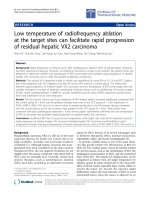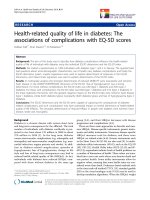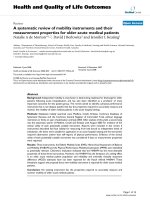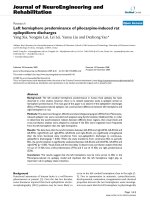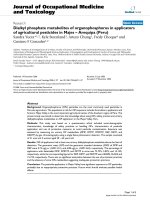Báo cáo hóa học: " Low Temperature Growth of In2O3 and InN Nanocrystals on Si(111) via Chemical Vapour Deposition Based on the Sublimation of NH4Cl in In" pdf
Bạn đang xem bản rút gọn của tài liệu. Xem và tải ngay bản đầy đủ của tài liệu tại đây (520.07 KB, 7 trang )
NANO EXPRESS
Low Temperature Growth of In
2
O
3
and InN Nanocrystals on
Si(111) via Chemical Vapour Deposition Based on the Sublimation
of NH
4
Cl in In
Matthew Zervos Æ Demetra Tsokkou Æ
Maria Pervolaraki Æ Andreas Othonos
Received: 30 November 2008 / Accepted: 27 January 2009 / Published online: 21 February 2009
Ó to the authors 2009
Abstract Indium oxide (In
2
O
3
) nanocrystals (NCs) have
been obtained via atmospheric pressure, chemical vapour
deposition (APCVD) on Si(111) via the direct oxidation of
In with Ar:10% O
2
at 1000 °C but also at temperatures as
low as 500 °C by the sublimation of ammonium chloride
(NH
4
Cl) which is incorporated into the In under a gas flow of
nitrogen (N
2
). Similarly InN NCs have also been obtained
using sublimation of NH
4
Cl in a gas flow of NH
3
. During
oxidation of In under a flow of O
2
the transfer of In into the
gas stream is inhibited by the formation of In
2
O
3
around the
In powder which breaks up only at high temperatures, i.e.
T [ 900 °C, thereby releasing In into the gas stream which
can then react with O
2
leading to a high yield formation of
isolated 500 nm In
2
O
3
octahedrons but also chains of these
nanostructures. No such NCs were obtained by direct oxi-
dation for T
G
\ 900 °C. The incorporation of NH
4
Cl in the
In leads to the sublimation of NH
4
Cl into NH
3
and HCl at
around 338 °C which in turn produces an efficient dispersion
and transfer of the whole In into the gas stream of N
2
where it
reacts with HCl forming primarily InCl. The latter adsorbs
onto the Si(111) where it reacts with H
2
O and O
2
leading to
the formation of In
2
O
3
nanopyramids on Si(111). The rest of
the InCl is carried downstream, where it solidifies at lower
temperatures, and rapidly breaks down into metallic In upon
exposure to H
2
O in the air. Upon carrying out the reaction of
In with NH
4
Cl at 600 °C under NH
3
as opposed to N
2
,we
obtain InN nanoparticles on Si(111) with an average diam-
eter of 300 nm.
Keywords Indium oxide Á Indium nitride Á Nanocrystals Á
Low temperature Á Chemical vapour deposition
One of the fundamental building blocks necessary for the
development of nanotechnology are semiconductor nanod-
ots (NDs), nanocrystals (NCs) or nanoparticles (NPs) viz.
quantum dots (QDs). These are completely quantised, zero
dimensional (0D) semiconductors with discrete energy
levels whose electronic and optoelectronic properties are
size dependent. Semiconductor QDs have been traditionally
obtained by strained layer growth using molecular beam
epitaxy (MBE) or chemical vapour deposition (CVD) [1, 2].
However, during recent years NDs, NCs and NPs have also
been obtained using complex chemical synthesis involving
solid, liquid and gas reactions and a broad variety of methods
including hydrothermal and colloidal synthesis. So far, NDs,
NCs, NPs have been realised from group IV elemental
semiconductors like Si [3, 4] and Ge [5] but also III-V and II-
VI compound semiconductors like GaAs [6], InP [7, 8], InN
[9] GaN [10], ZnS [11, 12], CdS [13] and oxides like ZnO
[14–17], SnO
2
[18] and In
2
O
3
[19–28]. Among the III-V’s,
nitride (N) semiconductors are especially attractive due to
the fact that their energy band gap can be adjusted over a
very wide range e.g. between 0.7 eV for InN up to 3.4 eV in
GaN by changing the composition of the ternary semicon-
ductor In
x
Ga
1-x
N over 0 B x B 1. On the other hand,
among the oxides, In
2
O
3
is a very important wide-band gap
semiconductor (E
G
= 3.55 eV) which is widely used for the
fabrication of devices such as electro-optic modulators, solar
cells, electro-chromic mirrors and sensors [29].
M. Zervos (&) Á M. Pervolaraki
Department of Mechanical and Manufacturing Engineering,
Materials Science Group, Nanostructured Materials and Devices
Laboratory, University of Cyprus, P.O. Box 20537,
1678 Nicosia, Cyprus
e-mail:
D. Tsokkou Á A. Othonos
Department of Physics, Research Centre of Ultrafast Science,
University of Cyprus, P.O. Box 20537, 1678 Nicosia, Cyprus
123
Nanoscale Res Lett (2009) 4:491–497
DOI 10.1007/s11671-009-9266-1
To date In
2
O
3
NCs have been obtained via CVD using
In
2
O
3
:In in a flow of Ar:CH
4
at 950 °C by Jia et al. [19]or
just Ar between 950 and 1300 °C by Cheng et al. [20] and
Guha et al. [21]. Similarly, chains of In
2
O
3
NCs have been
obtained by direct oxidation of In which was heated to
900 ° C[25]. High yields are critical in order to success-
fully fabricate nano-devices and low temperatures
desirable for compatibility with mainstream silicon pro-
cesses but also those involving polymers. One of the
shortcomings in the synthesis of In
2
O
3
nanostructures
obtained by CVD is the fact that until now high tempera-
tures have been used. Low temperature synthesis of In
2
O
3
NPs has been demonstrated via the sol–gel method by
Zhou et al. [22], which took, however, [100 h and
involved annealing between 500 and 850 °C. In addition, a
high yield-low temperature synthesis of single crystalline
tin doped indium oxide octahedrons via a low temperature,
catalyst-free process was also demonstrated by Wei et al.
[23], who obtained nanostructures as low as 450 °C using a
solution of indium acetate and tin chloride. Therefore, there
is active interest in the low temperature synthesis of In
2
O
3
NCs and an active, growing interest in InN QDs which
have been grown by MBE or metal organic CVD (MOC-
VD) predominantly on GaN, AlN, Al
2
O
3
. Very few
investigations have been carried out on the synthesis of
colloidal InN NPs [9] while recently indium oxynitride
which can be thought of as an alloy between InN and In
2
O
3
was investigated and proposed for optoelectronic device
applications [30].
In this work, we have investigated the synthesis of In
2
O
3
NCs by direct oxidation of In with O
2
in an atmospheric
pressure (APCVD) reactor and the limitations that arise as
a consequence of the direct oxidation process. We find that
during direct oxidation of In by O
2
the transfer of In into
the gas stream is inhibited by the formation of an In
2
O
3
shell around the In powder which melts at 157 °C. The
In
2
O
3
shell breaks up only at high growth temperatures
(T
G
) i.e. T
G
[ 900 °C, thereby releasing In into the gas
stream which in turn reacts with O
2
leading to the forma-
tion of a high yield of In
2
O
3
octahedrons with sizes of
500 nm but also chains of these nanostuctures. No such
nanostructures were obtained by direct oxidation for
T \ 900 °C. We find that including NH
4
Cl into the In
under a gas flow of N
2
leads to the sublimation of NH
4
Cl
into NH
3
and HCl at around 338 °C which results into the
complete transfer of the In precursor into the gas stream of
N
2
where it reacts with HCl and forms InCl that adsorbs
onto the Si(111) and reacts with H
2
O and O
2
forming In
2
O
3
nanopyramids at temperatures as low as 500 °C. Upon
carrying out the reaction under NH
3
as opposed to N
2
we
obtain InN nanoparticles with an average diameter of
300 nm. The low temperature growth of InN and In
2
O
3
NCs directly on Si(111) using a common type of reaction
could be exploited for the synthesis of InN/In
2
O
3
hetero-
nanostructures for a diverse range of applications such as
solar cells, sensors, etc.
Experimental
The In-based nanostructures were grown using an APCVD
reactor which consists of four mass flow controllers
(MFC’s) and a horizontal quartz tube furnace, capable of
reaching a maximum temperature of 1100 °C. More spe-
cifically, we used n
?
Si(111) and n
?
Si(111) covered with a
thin layer of Au that had a thickness of a few nm’s. The
Si(111) samples had an area of &1cm
2
and initially they
were immersed in HF, rinsed in de-ionised water and dried
with nitrogen prior to the deposition of the Au layer in
order to remove the native oxide and surface contamina-
tion. The Au layer was deposited via sputtering at a rate of
0.1 nm/s using an Ar plasma under a pressure\10
-4
mBar.
For the purpose of optical measurements all of the In-based
NCs were grown directly on quartz.
In the case of direct oxidation at high temperatures, fine
In powder (Aldrich, Mesh-100, 99.99%) was weighed and
loaded into a quartz boat together with a Au/Si(111) and
plain Si(111) sample. The Au/Si(111) sample was posi-
tioned about 5 mm over the In and the Si(111) about
10 mm downstream from the In powder. Then the boat was
loaded into the quartz tube reactor and positioned directly
above the thermocouple used to measure the heater tem-
perature at the centre of tube. After loading the boat at
room temperature (RT), Ar (99.999%) was introduced at a
flow rate of 500 standard cubic centimetres per minute
(sccm) for 10 min, in order to purge the tube. Following
this, the temperature was ramped to the desired growth
temperature (T
G
) in a reduced Ar flow of 100 sccm. Upon
reaching T
G
the flow of Ar was reduced to 90 sccm and O
2
introduced at a flow of 10 sccm for another 60 min after
which the O
2
flow was cut off and the quartz tube was
allowed to cool down over at least 60 min in an inert gas
flow of Ar, 100 sccm. The sample was removed only when
the temperature was lower than 100 °C.
For the synthesis of In
2
O
3
NCs at low temperatures, an
equimolar mixture of In powder (Aldrich, Mesh-100,
99.99%) and NH
4
Cl (99%, VWR) was prepared and loaded
in the centre of the quartz boat. A Au/Si(111) sample was
positioned over the mixture of In and NH
4
Cl and a Si(111)
sample without Au downstream from the mixture as
described above. After loading the boat at room tempera-
ture (RT), nitrogen N
2
(99.999%) was introduced at a flow
rate of 500 sccm for 15 min in order to purge the tube.
Following this, the temperature was ramped to the desired
growth temperature (T
G
)inaN
2
flow of 100 sccm’s. Upon
reaching T
G
the flow of N
2
was maintained at 100 sccm for
492 Nanoscale Res Lett (2009) 4:491–497
123
a further 60 min after which the quartz tube was allowed to
cool down over at least 60 min. Finally the InN NCs were
obtained by using an equimolar mixture of In:NH
4
Cl and
exactly the same growth conditions that led to the forma-
tion of InN nanowires by direct nitridation of In at 600 °C
under a gas flow of 250 sccm NH
3
which is described in
detail elsewhere [31].
The morphology of the nanostructures were examined
with a TESCAN scanning electron microscope (SEM) and
the crystal structure and phase purity of the nanostructures
were investigated using a SHIMADZU, XRD-6000, X-ray
diffractometer and Cu, Ka source. A scan of h–2h in the
range between 10° and 80° was performed for the nano-
structures grown under different conditions. For the XRD
we used Al and stainless steel (Fe
3
C) holders to place the
samples on the goniometer. In some of the XRD patterns
the characteristic peaks of the holder material were
detected and identified. Finally, optical spectroscopy was
carried out using a standard spectrophotometer UV/V
(Perkin Elmer Lambda 950) in the reflection mode at near
normal incident to minimise scattering effects from the
sample.
Results
In the case of direct oxidation of In with O
2
we observed
the formation of In
2
O
3
NCs only for T
G
C 900 °C and a
typical SEM image of In
2
O
3
NCs grown at T
G
= 1000 °C
is shown in Fig. 1a. Following the reaction we found that
the In powder had expanded significantly into a porous like
solid which disintegrated easily into a powder while a
bright yellow dust corresponding to the In
2
O
3
NCs was
found on the Si(111) but also in plentiful supply on the
sides of the quartz tube. The In
2
O
3
NCs are octahedrons
and had the tendency to form large dendrites consisting of
In
2
O
3
NC chains as shown in Fig. 1b and c, respectively.
The small In
2
O
3
NCs have a diameter of &500 nm, while
the sizes of the larger octahedrons are almost &2500 nm.
The surface density of the In
2
O
3
NCs across the surface
of the Si(111) was very uniform and the density of the
dendrites was dependent on the amount of In and the dis-
tance of the silicon from the In. The In
2
O
3
NCs grown at
T
G
= 1000 °C on silicon exhibited clear peaks in the X-ray
diffraction spectra shown in Fig. 2 and have a cubic
structure, while the optical bandgap is near 3.5 eV as
determined from the reflection spectrum shown in Fig. 3.
As already stated above, no nanostructures were
obtained for T
G
\ 900 °C in the presence of O
2
and the In
powder which melts at 157 °C forms a well-defined sphere
in the quartz boat found after each growth run. The surface
of the In had a grey, non-reflective appearance as opposed
Fig. 1 In
2
O
3
NCs grown on Si(111) by direct oxidation of In with O
2
at 1000 °C(a) Isolated NCs with min diameter of 500 nm (b)
Dendrite structure consisting of chains of NCs (c) Side view of NC
chains
Nanoscale Res Lett (2009) 4:491–497 493
123
to the highly reflective surface of In which we always
obtained during the growth of InN from In and NH
3
[31].
In contrast to the above findings, the reaction of In and
NH
4
Cl occurred efficiently even at temperatures as low as
400 ° C, since no trace of the In:NH
4
Cl mixture whatsoever
was found in the boat after removing the latter from the
quartz tube. In addition, a dark yellow powder was always
found near the cool end of the reactor which rapidly turned
into metallic grey upon exposure to the ambient air.
A typical SEM image of In
2
O
3
NCs obtained on Si(111)
at 600 °C after the reaction of In with NH
4
Cl under N
2
is
shown in Fig. 4a. Larger In
2
O
3
NCs were obtained at
T
G
= 500 °C, as shown in Fig. 4b. Interestingly, no
nano-pyramids were obtained on the Si(111) that was
covered with a few nm’s of Au and positioned directly over
the In:NH
4
Cl mixture.
Discussion
To date In
2
O
3
NCs have been obtained using CVD either
by direct oxidation of In or by reduction of In
2
O
3
at high
temperatures [19–21]. In the case of direct oxidation of In
with O
2
a shell of In
2
O
3
forms around the molten source of
In. This shell inhibits the transfer of In into the gas stream,
so it is necessary to increase the temperature above 900 °C
in order to break the shell and ensure an adequate transfer
of In into the gas stream. This leads to an apparent
expansion of the In very similar to that which occurs during
the nitridation of Al when it reacts with NH
3
. In the latter
Fig. 2 XRD spectrum of In
2
O
3
NCs grown on Si(111) (i) by direct
oxidation of In by Ar:10% O
2
at 1000 °C, i.e. CVD71, top pattern and
(ii) by reaction of In with NH
4
Cl at 600 °C under a flow of N
2
i.e.
CVD59, lower pattern. Enhanced In
2
O
3
peaks are obtained from the
sample grown at the higher temperature
1.5 2.0 2.5 3.0 3.5 4.0 4.5
0.70
0.75
0.80
0.85
0.90
0.95
CVD71
Reflection
Photon Energy (eV)
Fig. 3 Reflection spectrum of the In
2
O
3
NCs grown at 1000 °C
directly on quartz
Fig. 4 (a)In
2
O
3
NCs as small as 200 nm were grown on Si(111) at
600 °C via the reaction of In and NH
4
Cl. The large pyramids have a
base almost equal to 2000 nm (b) Coalescence of In
2
O
3
NCs into
small flower like structures at 500 °C
494 Nanoscale Res Lett (2009) 4:491–497
123
case, when Al is heated up in a flow of N
2
:NH
3
it leads to
the formation of AlN around the source of Al which in turn
inhibits the transfer of Al into the gas stream and conse-
quently the growth of AlN. At high temperatures the
molten Al expands and breaks the surrounding AlN shell
thereby releasing Al. After cool down the residual Al
appears to have expanded and has a porous like appear-
ance. The formation of AlN on the Al source has been
shown to be inhibited by incorporating NH
4
Cl in the
Al. The decomposition of NH
4
Cl enhances the porosity of
the Al melt thereby promoting the transfer of Al into the
gas stream. On the other hand, the reaction of NH
4
Cl
and Al leads to the formation of AlCl
3
which is a gas
and this reacts in turn with nitrogen giving AlN
according to,
NH
4
Cl
SðÞ
À! NH
3
þ HCl ð1Þ
Al þ3HCl À!AlCl
3
þ
3
2
H
2
ð2Þ
AlCl
3
þ
1
2
N
2
þ
3
2
H
2
À! AlN þ 3HCl: ð3Þ
In the case of In, we find that incorporation of NH
4
Cl
leads to the complete transfer of the solids of In and NH
4
Cl
into the gas stream of N
2
. Indium has a low melting point
of 156 °C and once molten it forms a sphere whose size
depends on the initial amount of powder. The complete
elimination of the In and NH
4
Cl is a direct consequence of
the sublimation of the NH
4
Cl into NH
3
and HCl which
occurs at 338 °C. According to Chaiken et al. [32], the
sublimation rate of NH
4
Cl increases by a factor of 10
4
when changing the temperature from T = 100–600 °C and
the typical sublimation weight loss of NH
4
Cl is over 90%
when heated for &60 min. Sublimation is endothermic and
the temperature is expected to be reduced only by a few
tens °C in the case of NH
4
Cl [32].
Consequently, the sublimation of NH
4
Cl enhances the
porosity of the In resulting into an efficient transfer of In
from the interior of the melt into the gas stream where it
subsequently reacts with the HCl thereby forming InCl,
InCl
2
and InCl
3
. However, gaseous InCl
3
at temperatures
[400 °C suffers decomposition and yields InCl and InCl
2
while the amount of InCl increases with increasing tem-
perature [33]. Thus, during growth for T [ 400 °C InCl
3
decomposes predominantly into InCl according to,
InCl
3
! InCl þ Cl
2
: ð4Þ
InCl is yellow, changes to red at 120 °C and has a
relatively low melting point of 216 °C. The InCl molecules
adsorb on the Si(111) surface and react with H
2
O possibly
absorbed by the NH
4
Cl to form In
2
O
3
NCs according to,
2InCl þ3H
2
O ! In
2
O
3
þ 2HCl þ 2H
2
: ð5Þ
A similar reaction involving spraying of InCl
3
.H
2
Oin
ethanol was recently employed for the deposition of a
polycrystalline thin film of In
2
O
3
on stripe-patterned Si at
280 ° C[34].
Fig. 5 (a) SEM image of the InN NCs grown at 600 °C on Si(111)
(b) high magnification of the hexagonally shaped InN NCs with
diameters 200–300 nm (c) XRD spectrum corresponding to single
phase hexagonal InN
Nanoscale Res Lett (2009) 4:491–497 495
123
The In
2
O
3
NCs have a stable, light yellow colour, even
after exposure to the ambient air. However, most of the
InCl is carried downstream as evidenced by the large
amounts of dark yellow powder found only near the cool
end of the reactor. Both InCl and InCl
2
decompose into In
and Cl when reacting with H
2
O and so lead to the sepa-
ration of metallic indium. Therefore, the rapid change of
the dark yellow powder to metallic grey upon exposure to
the ambient air is attributed to the humidity of the air, i.e.
H
2
O. It is important to point out that the In
2
O
3
NCs were
also obtained via the sublimation of NH
4
Cl in In under the
presence of O
2
for T \ 900 °C. In contrast, no In
2
O
3
NCs
were obtained in the case of the oxidation of In alone by O
2
for T \ 900 °C. The formation of In
2
O
3
pyramidal NCs on
Si(111) was confirmed by the XRD spectrum shown in
Fig. 2. In both XRD spectra illustrated in Fig. 2, only the
In
2
O
3
reflections are observed ensuring the absence of a
second phase. All In
2
O
3
peaks in Fig. 2 correspond to the
In
2
O
3
peaks also observed by Du et al. [35] who have
grown In
2
O
3
structures by dehydration of In(OH)
3
after
heat treatment at 500 °C for 4 h. The In
2
O
3
peaks have
higher intensities for growth temperatures above 600 °C.
On the other hand, the sublimation of NH
4
Cl in the In
under a gas flow of NH
3
does not yield pyramidal NCs.
Upon carrying out the reaction of In with NH
4
Cl in a gas
flow of 250 sccm of NH
3
as opposed to N
2
at 600 °C[31]
we obtained single phase, hexagonal structured InN NPs
with an average diameter of 300 nm as shown in Fig. 5b
and confirmed by XRD shown in Fig. 5c where the (002),
(101), (103) and (112) reflections of the InN, Si (111) and
the stainless steel holder peaks are observed. In this case
the InCl reacts with the NH
3
giving InN similar to the
recent investigation of Kumagai et al. [36] on hydride
vapour phase epitaxy of InN epitaxial layers via the reac-
tion of InCl
3
with NH
3
. These InN NCs are also very
similar in size and morphology with those obtained by
MOCVD on GaN [2].
An interesting aspect of the In
2
O
3
NCs obtained from
the reaction of In with NH
4
Cl is that they self-assemble
into well-defined circles for T B 600 °C, as shown in
Fig. 6a and coalesce near the periphery leading to the
formation of lm size, flower-like structures, as shown in
Fig. 6batT = 500 °C resembling a wreath. Upon reducing
the temperature to 400 °C we do not find anymore isolated
In
2
O
3
NCs but only lm size flower-like structures which
now fill the wreaths, as shown in Fig. 6c. This type of self-
assembly was not observed for the In
2
O
3
NCs grown by
direct oxidation of In with O
2
at T [ 900 °C which
aggregate into dendrites that consist of NC-chains. A
possible explanation for this type of self-assembly is wet-
ting of the Si(111) surface by In. The wetting is not
uniform across the sample but instead the In forms wet
circular regions on the Si(111) surface which tend to
Fig. 6 a Coalescence of In
2
O
3
NCs at the periphery of a well-defined
circle and formation of flower-like structures b Coalescence of In
2
O
3
NCs into ‘flowers’ and formation of a wreath spanning over 20 lm,
obtained at T
G
= 500 °C c Large wreath full of flower-like structures
spanning over almost 200 lm obtained at T
G
= 400 °C and d 20 lm
isolated flower-like structure
496 Nanoscale Res Lett (2009) 4:491–497
123
expand as the growth proceeds thereby leading to the
coalescence of the NCs and the formation of the wreath-
like structures shown in Fig. 6a–d. These wreath-like
structures become larger when decreasing the temperature
and the individual flower-like structures may grow up to
20 lm, Fig. 6d.
Conclusion
We have investigated the synthesis of In
2
O
3
NCs by direct
oxidation of In with O
2
and also by the incorporation of
NH
4
Cl in the In under N
2
. The reaction of In and NH
4
Cl
yields InN NCs using NH
3
. The synthesis of In
2
O
3
NCs by
direct oxidation of In with O
2
is limited by the formation of
an oxide shell surrounding the In which can be eliminated
only at T
G
[ 900 °C as a consequence of the expanding
melt therefore allowing an efficient transfer of In into the
main gas stream. At T
G
[ 1000 ° C we obtain 500 nm size
In
2
O
3
NCs but also dendrite structures consisting of NC
chains.
The high temperature requirement can be alleviated by
the addition of NH
4
Cl into the In which breaks down into
NH
3
and HCl by sublimation thus resulting into the com-
plete transfer of the In into the gas stream and the
formation of InCl which reacts with H
2
O and O
2
. In this
way we obtained In
2
O
3
NCs at temperatures as low as
500 ° C under N
2
but also InN by simply changing from N
2
to NH
3
. This method is potentially interesting for the
synthesis of narrow and wide-band gap InN and In
2
O
3
NCs
at low temperatures but also for nano-engineering of het-
erostructures and the fabrication of novel devices such as
third generation solar cells.
References
1. J.G. Lozano, A.M. Sa
´
nchez, R. Garcı
´
a, S. Ruffenach, O. Briot, D.
Gonza
´
lez, Nanoscale Res. Lett. 2, 442 (2007). doi:10.1007/s11671-
007-9080-6
2. O. Briot, B. Maleyre, S. Ruffenach, Appl. Phys. Lett. 83, 2919
(2003). doi:10.1063/1.1613044
3. T. Yoshida, S. Takeyama, Y. Yamada, K. Mutoh, Appl. Phys.
Lett. 68, 68 (1996). doi:10.1063/1.116662
4. X.D. Pi, R. Gresback, R.W. Liptak, S.A. Campbell, U. Kortsha-
gen, Appl. Phys. Lett. 92, 123102 (2008). doi:10.1063/1.2897291
5. J.P. Wilcoxon, P.P. Provencio, G.A. Samara, Phys. Rev. B 64,
035417 (2001). doi:10.1103/PhysRevB.64.035417
6. J. Perrie
`
rre, E. Millon, M. Chamarro, M. Morcrette, C. Andre-
azza, Appl. Phys. Lett. 78, 2949 (2001). doi:10.1063/1.1370992
7. S. Wei, J. Lu, W. Yu, Y. Qian, J. Appl. Phys. 95, 3683 (2004).
doi:10.1063/1.1650883
8. D. Bertram, O.I. Mic
´
ic
´
, A.J. Nozik, Phys. Rev. B 57, R4265
(1998). doi:10.1103/PhysRevB.57.R4265
9. M.R. Greenberg, W. Chen, B.N. Pulford, G.A. Smolyakov, J.S.
Ying-Bing, D. Bunge, T.J. Boyle, Proc SPIE 5705, 68 (2005).
doi:10.1117/12.601507
10. O.I. Mic
´
ic
´
, S.P. Ahrenkiel, D. Bertram, A.J. Nozik, Appl. Phys.
Lett. 75, 478 (1999). doi:10.1063/1.124414
11. R.B. Little, M.A. El-Sayed, G.W. Bryant, S. Burke, J. Chem.
Phys. 114, 1813 (2001). doi:10.1063/1.1333758
12. D.R. Jung, D. Son, J. Kim, C. Kim, B. Park, Appl. Phys. Lett. 93,
163118 (2008). doi:10.1063/1.3007980
13. N.V. Hullavarad, S.S. Hullavarad, J. Vac. Sci. Technol. A 26,
1050 (2008). doi:10.1116/1.2940346
14. M. Ghosh, A.K. Raychaudhuri, J. Appl. Phys. 100, 034315
(2006). doi:10.1063/1.2227708
15. L.B. Duan, G.H. Rao, J. Yu, Y.C. Wang, W.G. Chu, L.N. Zhang,
J. Appl. Phys. 102, 103907 (2007). doi:10.1063/1.2815647
16. M. Snure, A. Tiwari, J. Appl. Phys. 104, 073707 (2008). doi:
10.1063/1.2988131
17. W.Q. Peng, S.C. Qu, G.W. Cong, Z.G. Wang, Appl. Phys. Lett.
88, 101902 (2006). doi:10.1063/1.2182010
18. N. Shirahata, A. Hozumi, A. Asakura, A. Fuwa, Y. Sakka, J. Vac.
Sci. Technol. A 23(4), 731 (2005). doi:10.1116/1.1863936
19. H. Jia, Y. Zhang, X. Chen, J. Shu, X. Luo, Z. Zhang, Appl. Phys.
Lett. 82, 4146 (2003). doi:10.1063/1.1582354
20. G. Cheng, E. Stern, S. Guthrie, M.A. Reed, R. Klie, Y. Hao, G.
Meng, L. Zhang, Appl. Phys. A85, 233 (2006)
21. P. Guha, S. Kar, S. Chaudhuri, Appl. Phys. Lett. 85, 3851 (2004).
doi:10.1063/1.1808886
22. H. Zhou, W. Cai, L. Zhang, Appl. Phys. Lett. 75, 495 (1999). doi:
10.1063/1.124427
23. M. Wei, D. Zhi, J.L. MacManus-Driscoll, Nanotechnology 17,
3523 (2006). doi:10.1088/0957-4484/17/14/027
24. J. Ederth, P. Johnsson, G.A. Niklasson, A. Hoel, A. Hulta
˚
ker, P.
Heszler, C.G. Granqvist, A.R. van Doorn, M.J. Jongerius, Phys.
Rev. B 68, 155410 (2003). doi:10.1103/PhysRevB.68.155410
25. T.S. Ko, C.P. Chu, J.R. Chen, Y.A. Chang, T.C. Lu, H.C. Kuo,
S.C. Wang, J. Vac. Sci. Technol. A 25, 1038 (2007)
26. A. Murali, A. Barve, V.J. Leppert, S.H. Risbud, I.M. Kennedy,
H.W.H. Lee, Nano. Lett. 1, 287 (2001). doi:10.1021/nl010013q
27. P. Zhu, W. Wu, J. Zhou, W. Zhang, Appl. Organomet. Chem. 21,
909 (2007). doi:10.1002/aoc.1300
28. G.Q. Ding, W.Z. Chen, M.J. Zheng, Z.B. Zhou, Appl. Phys. Lett.
89, 063113 (2006). doi:10.1063/1.2335665
29. X J. Huang, Y K. Choi, Sens Actuators B122, 659 (2007)
30. J. T-Thienprasert, J. Nukeaw, A. Sungthong, S. Porntheeraphat,
S. Singkarat, D. Onkaw, S. Rujirawat, S. Limpijumnong, Appl.
Phys. Lett. 93, 0519031 (2008). doi:10.1063/1.2965802
31. A. Othonos, M. Zervos, M. Pervolaraki, Nanoscale Res. Lett. 4,
122 (2009)
32. R.F. Chaiken, D.J. Sibbett, J. Sutherland, D.K. Van de Mark, A.
Wheeler, J. Chem. Phys. 37, 2311 (1962). doi:10.1063/1.1733003
33. A. Haaland, The Molecular Structures of Main Group Element
Compounds, Chap. 11, Oxford University Press US (2008), ISBN
019923535X, 9780199235353
34. T. Kondo, H. Funakubo, K. Akiyama, H. Enta, Y. Seki, M.H.
Wang, T. Uchida, Y. Sawada, J. Cryst. Growth (2008) (in press)
35. J. Du, M. Yang, S.N. Cha, D. Rhen, M. Kang, D.J. Kang, Cryst.
Growth Des. 8, 2312 (2008). doi:10.1021/cg701058v
36. Y. Kumagai, J. Kikuchi, Y. Nishizawa, H. Murakami, A. Kouk-
itu, J. Cryst. Growth 300, 57 (2007). doi:10.1016/j.jcrysgro.
2006.10.202
Nanoscale Res Lett (2009) 4:491–497 497
123
